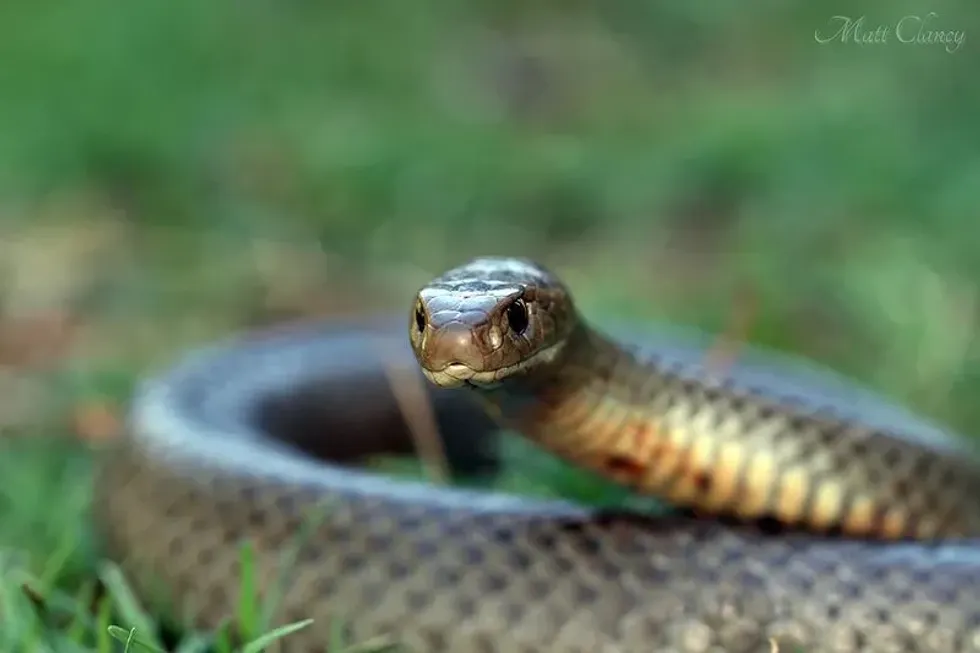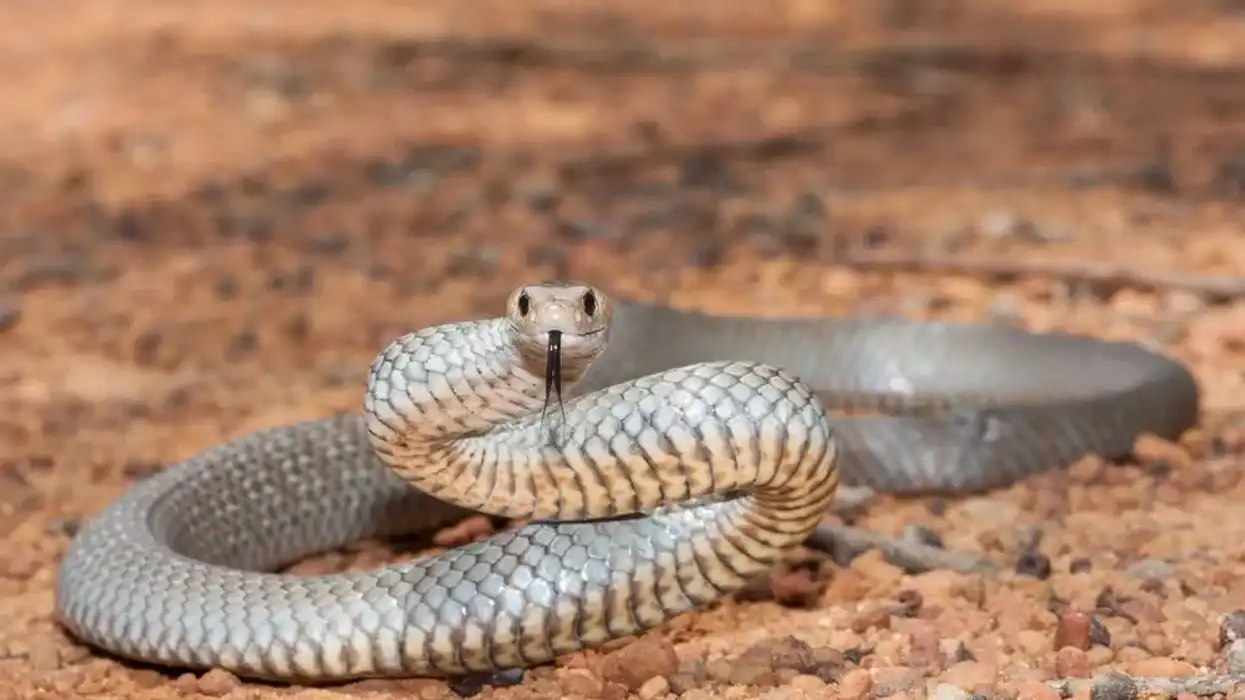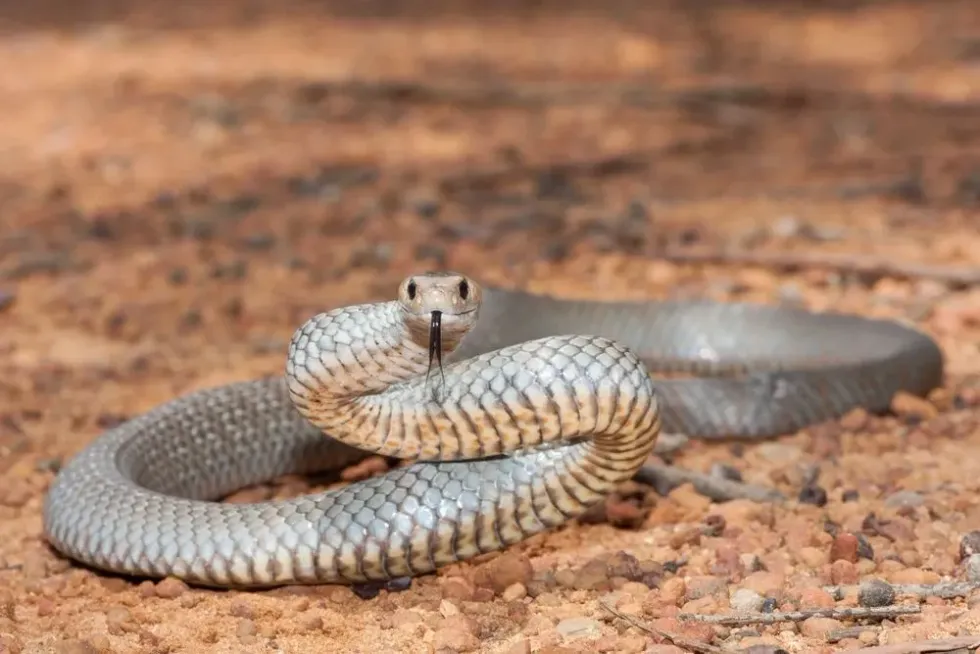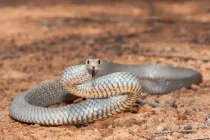Fun Eastern Brown Snake Facts For Kids

Content
- What type of animal is an Eastern Brown Snake?
- What class of animal does an Eastern Brown Snake belong to?
- How many Eastern Brown Snakes are there in the world?
- Where does an Eastern Brown Snake live?
- What is an Eastern Brown Snake's habitat?
- Who do Eastern Brown Snakes live with?
- How long does an Eastern Brown Snake live?
- How do they reproduce?
- What is their conservation status?
- What do Eastern Brown Snakes look like?
- How cute are they?
- How do they communicate?
- How big is an Eastern Brown Snake?
- How fast can an Eastern Brown Snake move?
- How much does an Eastern Brown Snake weigh?
- What are the male and female names of the species?
- What would you call a baby Eastern Brown Snake?
- What do they eat?
- Are they poisonous?
- Would they make a good pet?
- Did you know...
- What to do if you see an Eastern Brown Snake?
- What is the difference between a King Brown and Eastern Brown Snake?
The Eastern brown snake is medium-sized and is also called the common brown snake. They are of the Elapidae family and are alert, fast-moving, and highly venomous snakes.
The adult eastern brown snakes are up to 78.7 in (200 cm) long. This is known to be the second most toxic snake in the world. They have glossy and smooth scales.
They are oviparous. They are native to the southern part of New Guinea and central, east, and South Australia.
In 1854, the zoologists Gabriel Bibron, Andre Marie Constant Dumeril, and Auguste Dumeril first described this species. The eastern brown snakes are brown to dark brown and are slender. These snakes are also found in shades of tan, olive, russet, or orange color.
They are bred in captivity and are available in Australia. The defensive displays of these snakes are sometimes misinterpreted as aggression by people.
The Taipan (Oxyuranus scutellatus) and Mulga snake (Pseudechis australis) are similar to this species. They grow up to 2 m long and live up to seven years. Feral cats, birds of prey, and red-bellied black snakes are the predators of this snake.
They are found in human habitats as they find house mice on agricultural lands. In New South Wales, these snakes are the second most reported for envenoming dogs.
If these facts are interesting, you may also like to read our Nile Monitor and puff adder facts.
Eastern Brown Snake Interesting Facts
What type of animal is an Eastern Brown Snake?
The eastern brown snake is a snake belonging to the Elapidae family.
What class of animal does an Eastern Brown Snake belong to?
The eastern brown snakes belong to the Reptilia class of reptiles.
How many Eastern Brown Snakes are there in the world?
The exact number of these snakes is unknown.
Where does an Eastern Brown Snake live?
These are land snakes and primarily occupy the east coast of Australia and Indonesia. This snake is found in Malanda, Queensland; New South Wales, Victoria, and Yorke Peninsula, South Australia.
In the Northern Territory, they are found in McDonnell Ranges and Barkly Tableland. In Western Australia, the snake occurs in the east Kimberly and Papua new guinea, and also in the Papua province in the Indonesian part of New Guinea.
What is an Eastern Brown Snake's habitat?
They are primarily distributed throughout Australia. Their population is high in dry and well-populated areas.
The eastern brown snake habitat includes heaths of coastal ranges across savannah woodlands, farmlands, arid scrublands, inner grasslands, and dry sclerophyll forests. This common brown snake is found in alpine regions, open habitats, and the outskirts of urban areas. The diet of these brown snakes includes rodents so they linger around houses and farms.
These areas have rubbish, buildings, and corrugated iron which these snakes use as shelter. They also make a habitat under burrows, cracks, and large rocks on the ground.
Who do Eastern Brown Snakes live with?
The eastern brown snakes live on their own except with young ones and females during spawning seasons. These brown snakes are active during the day and hot weather, they retire and come out in late afternoons. They have shown nocturnal qualities as well.
They use the burrow made by mice, rats, rabbits, or skinks. They have been spotted sunbathing on warm days. These snakes hibernate during winter.
How long does an Eastern Brown Snake live?
As per research, these brown snakes live up to 15 years in captivity. Their lifespan in the wild is unknown.
How do they reproduce?
The male eastern brown snakes come out earlier in the mating season than the female eastern brown snakes. During the southern hemisphere spring, mating occurs between male and female eastern brown snakes.
To access the female two males combat each other. This combat looks like a pleated rope. The females mate with the most dominant male.
The development of yoking follicles in females takes place between mid-September to the end of November. Between late October to January, the females have oviducal eggs.
Females then produce 10-35 eggs, which weigh around 8 g each. The females eat only a few times when they are pregnant. In captivity, it was observed that females coil around eggs, which can either be a recovery from labor or maternal care.
Also, it was shown that the females can hold the sperm for several weeks after mating. The eggs are placed in communal nests as a large number of eggs can be found in a rabbit warren.
The eggs can take between 36-95 days to hatch, which depends on the temperature. The babies can stay in the eggs for about four to eight hours. The eastern brown snake babies differ in patterns, but one common aspect is that they all have bands on their heads and neck.
The juvenile eastern brown snake hunt and eat at night. The growth rate of these snakes is high.
What is their conservation status?
The conservation status of these Australian snakes has not been evaluated. They live near the human population and eat house mice. Feral cats and birds of prey hunt these Australian snakes. They are also killed by road vehicles and landowners. The roundworms, tapeworms, and tongues warms are the endoparasites of these Australian snakes.
Eastern Brown Snake Fun Facts
What do Eastern Brown Snakes look like?
These eastern brown snakes are average-built and slender-bodied snakes and demarcation between their neck and the head is absent. When viewed from the top its snout is round.
The adult snakes are either russet, orange, tan to olive, dark gray-brownish to blackish, or pale to dark brown. The southern snakes are smaller than the northern snakes. They have medium-sized orange eyes.
The pupil of this snake has an orange or yellow-brown ring and the iris is black. This snake has a dark tongue and the fangs are 0.1-0.15 in (2.8-4 mm) long and are 0.4 in (1.1 cm) apart.
The underparts of the snake are pale yellow or cream. The juvenile land snake has black bands which fade away as they age. They have a light brown snout and blackhead.
Inside their mouth, the western brown snake and northern brown snake have black skin whereas the eastern brown snake has flesh pink skin. Another identification factor of these species is the number of scales and arrangements on their body.
These Australian snakes have a divided anal scale and 45-75 divided subcaudal scales. At midbody, they have 17 rows of dorsal scales and ventral scales between 192-231. They have six supralabials and often seven sublabial scales around the mouth.
Their nasal scales are not divided and are sometimes partly divided. They have two to three postocular scales around the eyes.

How cute are they?
According to most people, these Australian brown snakes are not cute.
How do they communicate?
Like all other snakes, this brown snake depends on its tongue to detect the presence of chemicals in the air and vibrations to detect movement. Their eyesight is relatively good
How big is an Eastern Brown Snake?
The eastern brown snakes are 58.8-79.2 in (149.3 -201.2 cm) in length.
How fast can an Eastern Brown Snake move?
These snake species are known to be very fast. They can also outrun a running human. The exact speed data is unavailable.
How much does an Eastern Brown Snake weigh?
The eastern brown snakes are 4.4 lb (2 kg) in weight.
What are the male and female names of the species?
There are no specific names for females and males of this species.
What would you call a baby Eastern Brown Snake?
The baby snake has no particular name.
What do they eat?
The diet of these Australian brown snakes includes mammals and vertebrates. Larger snakes consume more warm-blooded prey whereas ones with smaller snout-vent lengths consume more ectothermic prey (lizards).
In over-covered spaces or captivity, they can show cannibalistic tendencies, eating snakes of about the same size as theirs. So, their common diet includes rats, mice, frogs, reptile eggs, reptiles, and birds. They have attempted to eat a large eastern bearded dragon but they were unsuccessful.
They have good eyesight and actively hunt in search of prey in hiding places. They kill by both venom injection and suffocating the pry.
Are they poisonous?
Yes, these species are poisonous. These snakes are the second most venomous snake in the world. The eastern brown snake bite can be fatal to humans if not treated immediately. Prothrombinase complex pseutarin-C is one of the main compounds of their venom. Humans can die within half an hour if this venom is left untreated.
They are also very territorial and protect their home. They are not aggressive but shy and show defensive behavior towards a threat.
They have two neck displays if triggered. The partial neck display is when they raise the front part of the body horizontally off the ground with a flat neck and open mouth. The full display is when they lift themselves much higher off the ground making an S shape with an open mouth.
In this position, they can bite a person's upper thigh. They tend to attack at close encounters and they notice dark clothing faster and change course on their own.
Would they make a good pet?
No. These species would not make good pets. Due to their high speed and toxicity only experienced individuals pet them. For research, professionals breed these brown snakes.
Did you know...
The most venomous eastern brown snake in the world called inland Taipan is the only rival of these brown snakes.
The longest recorded Australian brown snake is 94.8 in (240.7 cm)
The common brown snakes are confused with the mulga snakes as they are found in similar habitats. The western brown snake is the prey of the mulga snake.
The Latin name 'Pseudonaja' means 'false cobra.'
The eastern brown snakes were known to the Eora and Darug population as marragawan in earlier days, in the Sydney basin. Goobalaang is the name of these species in Illawarra and Dharawal. In the Wiradjuri language of New South Wales, brown snakes are called warralang.
To swallow its prey it can even dislocate its jaw. Also, the flexible skin helps them swallow without any discomfort.
The eastern brown snakes live neither in extremely dry areas nor do they live in wet areas.
The eastern brown snakes have smaller heads and girth than the king brown snakes.
The eastern brown snakes are susceptible to the toxins of the cane toad. The young ones and adult snakes have learned to avoid these species.
By hunting down rodents in agricultural fields and farms these species control rodent pests. This also means that farmers work in the dangerous presence of these snakes.
Sixty percent of snake bite deaths are caused by these venomous snakes. The hatchling's venom is enough to kill humans. The juvenile brown snake's venom differs from the adults but the clotting time is not impacted even though prothrombinases were absent in young ones. It is difficult to detect a bite as it is painless.
Even though these species are most venomous, there are only two deaths per year due to their bites. It is 50 times more likely for humans to die by falling off their beds than by a snake's bite.
What to do if you see an Eastern Brown Snake?
When you come across the Australian brown snakes, like any other snakes it is necessary to remain calm. It is important to not try to capture or hurt these Australian venomous snakes.
If these snakes are spotted it is advised to call a professional snake catcher. If your pets show signs of illness like salivation, lethargy, vomiting, or collapsing they need to be taken to a vet as it is very difficult to detect a snake bite. It is also advised to cut short the lawns and keep your house clean.
While traveling in the areas with these snakes try to avoid unknown paths and dense undergrowth. Make sure to wear solid footwear, thick socks, and long pants.
In case you get a snake bite, call the emergency service immediately. It is necessary to stay still as movement can shift the poison in your body. It is a myth to suck the venom out of the bite.
Venom can help doctors to prescribe the necessary anti-venom. Do not apply a high tourniquet to the bite. Do not cut or clean the area. It is advised to put pressure on the area to stop the spread of venom.
Some can show different signs and some might not. This depends on the physiology of a person and the amount of venom. The venom can cause acute kidney injury, coagulopathy, severe complications, myotoxicity, and major hemorrhage.
What is the difference between a King Brown and Eastern Brown Snake?
The king brown snake is Pseudechis australis and the eastern brown snake is Pseudonaja textilis and both are of Australian origin. There are many differences between the two.
The king brown snake is longer than the eastern brown snake.
The king brown snakes bite relatively less and toxicity in their venom is less than these Australian brown snake's venom.
The king brown snakes are found in the central part of Australia whereas the eastern brown snakes are native to eastern Australia. The king brown snake has separate temporolabial and last supralabial scales whereas these scales are fused or attached in eastern brown snakes.
In warmer climates, king brown snakes are active during the night whereas the eastern brown snakes are active during the day and late afternoon. The king brown snake yields an average of 180 mg of venom in one bite whereas eastern brown snakes yield less than 5 mg, which is less than the most dangerous species in Australia.
The bite area often goes unnoticed in the case of eastern brown snakes but the king brown snake bites are painful and it gets swollen and damages the tissues.
Here at Kidadl, we have carefully created lots of interesting family-friendly animal facts for everyone to discover! Learn more about some other reptiles including black racer snakes or pygmy rattlesnakes.
You can even occupy yourself at home by drawing one on our Eastern Brown Snake coloring pages.
We Want Your Photos!
More for You
Bachelor of Engineering specializing in Aeronautical/Aerospace Technology, Master of Business Administration specializing in Management

Arpitha RajendraBachelor of Engineering specializing in Aeronautical/Aerospace Technology, Master of Business Administration specializing in Management
With a background in Aeronautical Engineering and practical experience in various technical areas, Arpitha is a valuable member of the Kidadl content writing team. She did her Bachelor's degree in Engineering, specializing in Aeronautical Engineering, at Nitte Meenakshi Institute of Technology in 2020. Arpitha has honed her skills through her work with leading companies in Bangalore, where she contributed to several noteworthy projects, including the development of high-performance aircraft using morphing technology and the analysis of crack propagation using Abaqus XFEM.
Bachelor of Science specializing in in Computer Science

Diya PatelBachelor of Science specializing in in Computer Science
A member of Kidadl's fact-checking team, Diya is currently pursuing a degree in Computer Science from Ahmedabad University with an interest in exploring other fields. As part of her degree, she has taken classes in communications and writing to expand her knowledge and skills.
Disclaimer
1) Kidadl is independent and to make our service free to you the reader we are supported by advertising. We hope you love our recommendations for products and services! What we suggest is selected independently by the Kidadl team. If you purchase using the Buy Now button we may earn a small commission. This does not influence our choices. Prices are correct and items are available at the time the article was published but we cannot guarantee that on the time of reading. Please note that Kidadl is a participant in the Amazon Services LLC Associates Program, an affiliate advertising program designed to provide a means for sites to earn advertising fees by advertising and linking to Amazon. We also link to other websites, but are not responsible for their content.
2) At Kidadl, we strive to recommend the very best activities and events. We will always aim to give you accurate information at the date of publication - however, information does change, so it’s important you do your own research, double-check and make the decision that is right for your family. We recognise that not all activities and ideas are appropriate for all children and families or in all circumstances. Our recommended activities are based on age but these are a guide. We recommend that these ideas are used as inspiration, that ideas are undertaken with appropriate adult supervision, and that each adult uses their own discretion and knowledge of their children to consider the safety and suitability. Kidadl cannot accept liability for the execution of these ideas, and parental supervision is advised at all times, as safety is paramount. Anyone using the information provided by Kidadl does so at their own risk and we can not accept liability if things go wrong.
3) Because we are an educational resource, we have quotes and facts about a range of historical and modern figures. We do not endorse the actions of or rhetoric of all the people included in these collections, but we think they are important for growing minds to learn about under the guidance of parents or guardians.







